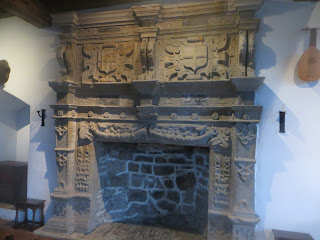On the twenty
third of March, we added to our list of places we have travelled to in order to
obtain a better understanding of Ireland. This time, although we were still in
the Republic of Ireland, we were in the northern county of Donegal exploring
the Donegal Castle. Hugh O’Donnell, ruler of Tirconnell, built it in the
fifteenth century. The O’Donnell family ruled the Kingdom of Tirconnell from
1200 to 1601. Predictably, since by the sixteenth century England had
significant power in Ireland due to the works of Henry VIII and Elizabeth I,
this castle was doomed to enter conflict with the English affairs. The Ulster
province was doing quite well in keeping Gaelic power—O’Neills of Tyrone,
O’Donnells of Tirconnell, and the Maguires of Fermanagh were still flourishing
until conflict arose. O’Donnell supported Maguire in his resistance to English
rule and, in 1595 O’Neill joined their forces as well, commencing the Nine
Years War. The Gaelic forces had to use quick ambush and retreat tactics
because of the military strength of England. Still, Lord Mountjoy arrived in
1600 forcing O’Donnell to flee the town of Donegal. Before leaving, however,
O’Donnell destroyed the castle rendering it useless to the English. Eventually,
O’Donnell died in Spain in 1602 and his successor, along with O’Neill and
Maguire fled to Spain in 1607 in what is known as the “Flight of the Earls.”
Ultimately, the English took control of the castle, which was granted to
Captain Basil Brooke. It remained in the Brooke family for sometime, but was
abandoned by the eighteenth century and granted to the Office of Public Works
in 1898. Restoration has taken place since, as recently as the 1990s.
Donegal Castle is beside the River
Eske in the town of Donegal. Strategically positioned, it was a superb
defensive structure as the river protected it on two sides. The castle is
composed of a fifteenth century rectangular keep and a seventeenth century Jacobean—named
after King James I—style wing. It is a typical castle made of limestone and
some sandstone. The inside is beautifully furnished with Persian rugs and
French tapestries. The exquisite fireplace inside the Banqueting Hall dates
from the seventeenth century and is regarded as one of the finest of its kind
in Ireland. It contains elaborate carvings and many symbols that tell the story
of whose hands the castle has been in. The carvings are also echoed in the
furniture. Despite the strategic position, exquisite carvings, and pleasant
furnishings, the castle is much more compact than other castles. Indeed, the
appearance and the history of the castle contribute to the construction of
historical Ireland.
Donegal Castle is a symbol of change
in Ireland. Ulster was resisting the English power, but it was inevitable that
England would eventually ascend in Ulster as they already had in much of
Ireland. After the English Crown took control of the castle, no more
significant Gaelic forces would rule the town of Donegal. The Nine Years War
not only changed this part of Ireland, but also essentially wiped out the last
of the strongest Gaelic lords. England would go on to ravage Ireland with
Cromwellian affairs, Ulster plantations, Catholic suppression, and peasant
exploitation. As this castle is relevant to historical Ireland, so it is also
relevant to modern Ireland.
Modern Ireland seems to be lost in
its culture and foundations. We can even see how to be Irish to some people,
means, essentially, to hate English. Our group does not see how a culture and a
people can successfully thrive and grown based on a hatred of a particular
people. But, it is stories like that of Donegal Castle that give substantial
merit to this hatred. Years of strife with a foreign nation will, undoubtedly,
render feelings of hatred and confusion. People may become so focused on this
hatred and resentment that they become nearsighted and blind to a more
altruistic outlook on life. Irish people are great and funny and intelligent,
but some seem to be apathetic in relation to pursuing healing and relationship.
Early on, Ireland was a powerful Christian nation and had a significant hand in
ministering to people within Ireland as well as foreigners in other countries.
But, the historical events that have taken place render Ireland disconnected
with this past. This is why even an Irish artist and speaker who spoke to us
describes the culture of Ireland as atheistic and lost. Today, the Irish do not
seem to be as much in a state of hatred, as they are indifferent to a wholeness
of life.
Our personal reactions to the castle
were relatively indifferent. We did not have a tour guide and it was much
smaller than other castles we have visited. Additionally, it was at the end of
a long day and many students rushed through the exhibits. Consequently, the
place did not seem to come alive to us. But, we were impressed with the stone
carvings of the fireplace as described above. We were surprised with its
closeness to the town of Donegal. The castle and the town center are adjacent
rendering a contrast between a modern living structure with a historic dead
structure. Perhaps, this helps us reflect on our view of Ireland. Ireland seems
to be dead to the world in which so much is happening. Upon leaving the castle,
the man in the office even commanded me to “have a pint and shed a tear for
Ireland.” The man continued to criticize the banking crisis and other issues of
modern Ireland. There was no sense of hope in his voice. The castle of Donegal,
indeed, tells the story of a people with a difficult history.
Fireplace in Banqueting Hall
Donegal Castle: Jacobean wing (left) and rectangular keep (right)
Inside Jacobean wing
Donegal Castle










